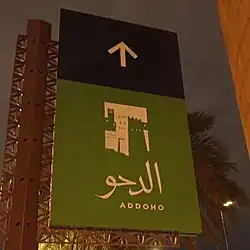Qasr Al Hukm District
Qasr al-Hukm District (Arabic: منطقة قصر الحكم, romanized: Minṭaqaẗ Qaṣr al-Ḥukm, lit. 'Governance Palace District') or the Justice Palace District (Arabic: منطقة قصر العدل, romanized: Minṭaqaẗ Qaṣr al-ʿAdl, lit. 'Justice Palace District'), is a term used to define the perimeters of the erstwhile fortress-city of Riyadh, Saudi Arabia in present-day neighborhoods of Dirah and Daho, encompassing several extinct douars (Arabic: حِلَّة, romanized: ḥilla) that once fell within the enclosure of the gates of old city walls prior to its demolition in 1950. Named after the eponymous al-Hukm Palace, it is widely considered to be the antecedent to modern Riyadh since the metropolis outgrew as an offshoot of the walled town in the 1950s.[1][2] It was rebuilt between 1970s and 1990s and is situated south of al-Batʼha commercial area besides being known for its historical and architectural significance.
Qasr Al-Hukm District
منطقة قصر الحكم | |
|---|---|
.jpg.webp) Masmak Fortress, 2011 | |
| Country | Saudi Arabia |
| City | Riyadh |
| Sub-municipality | Al Batʼha |
| Hajr disintegration | 16th century CE |
| Ibn Dawwas's takeover | 1737 |
| Wahhabi takeover | 1773 |
| Turki's takeover | 1824 |
| Battle of Riyadh | 1902 |
| Demolition of city walls | 1950 |
| Qasr Al Hukm District Development Project | 1973 |
| Named for | Al Hukm Palace |
It hosts some of the most important cultural heritage landmarks in the city, such as Masmak Fortress, Imam Turki bin Abdullah Grand Mosque, Deera Square and the eponymous al-Hukm Palace besides several traditional marketplaces.[3]
History and background

Following the demolition of Riyadh's city walls, death of King Abdulaziz and along with the rapid expansion and modernization of the city between 1950s and 1960s, the al-Hukm Palace and its surrounding areas had slowly begun to decline in importance. Many neighborhoods such as Duhairah was abandoned by its residents in pursuit of better opportunities in north of the capital. During the reign of King Faisal, Saudi authorities began focusing on the resuscitation and rejuvenation of the area and the preservation of its historical and architectural significance.[3]
In March 1973, King Faisal issued directives to Sheikh Abdulaziz Thunayyan, then mayor of Riyadh to conduct an extensive study of the area surrounding the al-Hukm Palace and implementing the project of its renovation the following year.[4] In 1976, the High Commission for the Development of Arriyadh commissioned the Qasr Al-Hukm District Development Project and agreed on developmental programs that were prepared to transform the Qasr al-Hukm District into a cultural center. The designs were completed by 1979 and the construction lasted between 1983 and 1992 in broadly two phases, costing around US$500 million.[5][6] The project was overseen by Prince Salman bin Abdulaziz al-Saud, the-then governor of Riyadh.
The project was completed in 1982, and was divided into three phases,
Phase 1 (1983–1988)
The first phase lasted between 1983 and 1988, in which the main offices of the Riyadh's governor, mayor and the regular police were constructed in the palace.[7][8]
Phase 2 (1988–1992)
The second phase lasted between 1988 and 1992, where the Imam Turki bin Abdullah Mosque, Qasr Al-Hukm, Al-Adl Plaza, Assafah Plaza, Imam Muhammad bin Saud Plaza, Al-Musmak Plaza, Al-Thumairi Gate, and Dekhna Gate, Ad-Deerah Tower were restored and built.[8][9]
Phase 3 (since 1992)
The third phase focused on winning confidence of the country's private sector. Headquarters of some institutions were constructed like the High Court, Civil Defense, Sheikh Muhammad bin Ibrahim Al Alsheikh Mosque, Dekhna Plaza, al-Zal Souq, and modern seven commercial complexes.
Gallery
 Deera Square, 2011
Deera Square, 2011
 Al Hukm Palace, 2022
Al Hukm Palace, 2022.jpg.webp) Souq al-Zal, 2014
Souq al-Zal, 2014 Safat Clocktower, 2023
Safat Clocktower, 2023 Souq al-Suweigah, 2023
Souq al-Suweigah, 2023 Bab al-Thumairi, 2023
Bab al-Thumairi, 2023.jpg.webp) Masmak Fortress, 2014
Masmak Fortress, 2014 Signboard of al-Doho neighborhood, 2023
Signboard of al-Doho neighborhood, 2023
Landmarks
References
- Bsheer, Rosie (2020-09-22). Archive Wars: The Politics of History in Saudi Arabia. Stanford University Press. ISBN 978-1-5036-1258-7.
- التميمي, مهنا (30 May 2019). "#من_ذاكرة_السعودية.. بوابات الرياض القديمة: أسوار من الطين المجفَّف.. وأبراج حراسة دائرية تُغلق ليلاً". صحيفة سبق الالكترونية (in Arabic). Retrieved 2023-01-21.
- Bsheer, Rosie (2020-09-22). Archive Wars: The Politics of History in Saudi Arabia. Stanford University Press. ISBN 978-1-5036-1258-7.
- "الخميس 26 محرم 1393 هـ الموافق 1 مارس 1973م - العدد (534)". www.al-jazirah.com. Retrieved 2023-03-27.
- Continuity and Change: Design Strategies for Large-scale Urban Development. Aga Khan Program for Islamic Architecture. 1984.
- MEED. Economic East Economic Digest, Limited. 1993.
- MEED. Economic East Economic Digest, Limited. 1992.
- "Qasr Al-Hukm District Development Project". Royal Commission for Riyadh City. Retrieved 2023-01-20.
- Bsheer, Rosie (2020-09-22). Archive Wars: The Politics of History in Saudi Arabia. Stanford University Press. ISBN 978-1-5036-1258-7.